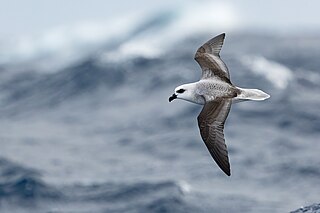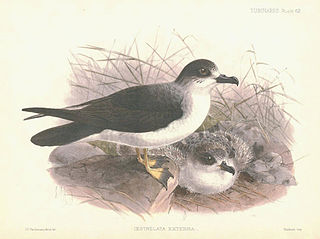
The gadfly petrels or Pterodroma are a genus of about 35 species of petrels, part of the seabird order Procellariiformes. The gadfly petrels are named for their speedy weaving flight, as if evading gadflies (horseflies). The flight action is also reflected in the name Pterodroma, from Ancient Greek pteron, "wing" and dromos, "runner".

The Fea's petrel is a small seabird in the gadfly petrel genus, Pterodroma. It was previously considered to be a subspecies of the soft-plumaged petrel, but they are actually not closely related at all. However, P. feae is very closely related to Zino's petrel and Desertas petrel, two other species recently split from P. mollis. The gadfly petrels are named for their speedy weaving flight, as if evading horseflies. The flight action is also reflected in the genus name Pterodroma, from Ancient Greek pteron, "wing" and dromos, " runner". This species is named after the Italian zoologist Leonardo Fea (1852-1903).

Zino's petrel or the freira, is a species of small seabird in the gadfly petrel genus, endemic to the island of Madeira. This long-winged petrel has a grey back and wings, with a dark "W" marking across the wings, and a grey upper tail. The undersides of the wings are blackish apart from a triangle of white at the front edge near the body, and the belly is white with grey flanks. It is very similar in appearance to the slightly larger Fea's petrel, and separating these two Macaronesian species at sea is very challenging. It was formerly considered to be a subspecies of the soft-plumaged petrel, P. mollis, but they are not closely related, and Zino's was raised to the status of a species because of differences in morphology, calls, breeding behaviour and mitochondrial DNA. It is one of Europe's most endangered seabirds, with breeding areas restricted to a few ledges high in the central mountains of Madeira.

The black-capped petrel, also known as the diablotín, is a small seabird native to the West Indies in the genus Pterodroma. It is a long-winged petrel with a grey-brown back and wings, with a white nape and rump. Underparts are mainly white apart from a black cap and some dark underwing markings. It picks food items such as squid from the ocean surface.

The magenta petrel, or Chatham Island tāiko, is a small seabird in the gadfly petrel genus, Pterodroma. Found exclusively on Chatham Island, New Zealand, it is one of the rarest birds in the world, believed to be extinct for over 100 years before its rediscovery in the 1970s.

Cook's petrel, or the tītī or blue-footed petrel, is a Procellariform seabird. It is a member of the gadfly petrels and part of the subgenus Cookilaria Bonaparte, 1856, which includes the very similar Stejneger's petrel.

The Bonin petrel or nunulu is a seabird in the family Procellariidae. It is a small gadfly petrel that is found in the northwest Pacific Ocean. Its secretive habits, remote breeding colonies and limited range have resulted in few studies and many aspects of the species' biology are poorly known.

The white-headed petrel, also known as the white-headed fulmar, is a species of seabird in the petrel family, Procellariidae. It is about 400 mm (16 in) in length.

The white-necked petrel, also known as the white-naped petrel, is a species of seabird in the family Procellariidae. During the non-breeding season it occurs throughout a large part of the Pacific, but it is only known to breed on Macauley Island in New Zealand's Kermadec Islands and the Australian territory of Norfolk Island and Phillip Island. It formerly bred on Raoul Island, but has now been extirpated from this locality due to predation by rats and cats. Reports of breeding on Merelava, Vanuatu, are more likely to be the very similar Vanuatu petrel, P. occulta, which some consider to be a subspecies of the white-necked petrel. The IUCN rating as vulnerable is for the "combined" species.

Masatierra petrel or De Filippi's petrel, is a species of seabird in the family Procellariidae. It is endemic to Chile where it nests in the Juan Fernández Islands and Desventuradas Islands. Its natural habitats are open seas and rocky shores.

The Juan Fernández petrel is a species of seabird in the family Procellariidae. It nests on a single island off the coast of Chile, in the Juan Fernández Archipelago. It was previously classified as a subspecies of the white-necked petrel, which is found in tropical waters of the Pacific and Indian Oceans.

The soft-plumaged petrel is a species of seabird in the family Procellariidae.

The black-winged petrel is a species of seabird in the family Procellariidae. It breeds on a number of oceanic islands in the tropical and subtropical East Pacific Ocean and spends the rest of the year at sea.
The Vanuatu petrel or Falla's petrel is a species of gadfly petrel. This little-known seabird was first scientifically described in 2001 based on six specimens taken in 1927 off Merelava, Vanuatu, and a single bird found ashore in 1983 in New South Wales, Australia. The first confirmed breeding locality was only discovered in 2009 on the island of Vanua Lava, Vanuatu, but based on reports by locals it is supposed to also breed on Merelava. The IUCN has not recognized the Vanuatu petrel as a species, but maintain that it as a subspecies of the very similar white-necked petrel, P. cervicalis, with the "combined" species considered vulnerable.

The Herald petrel is a species of seabird and a member of the gadfly petrels. Its range includes the south Pacific Ocean and Indian Ocean.
















